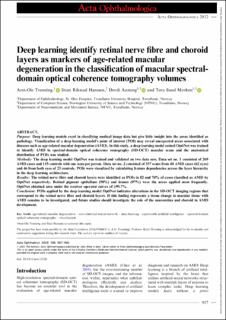| dc.contributor.author | Tvenning, Arnt-Ole | |
| dc.contributor.author | Hanssen, Stian Rikstad | |
| dc.contributor.author | Austeng, Dordi | |
| dc.contributor.author | Morken, Tora Sund | |
| dc.date.accessioned | 2023-03-16T11:06:16Z | |
| dc.date.available | 2023-03-16T11:06:16Z | |
| dc.date.created | 2022-05-02T11:43:59Z | |
| dc.date.issued | 2022 | |
| dc.identifier.citation | Acta Ophthalmologica. 2022, 1-9. | en_US |
| dc.identifier.issn | 1755-375X | |
| dc.identifier.uri | https://hdl.handle.net/11250/3058713 | |
| dc.description.abstract | Purpose
Deep learning models excel in classifying medical image data but give little insight into the areas identified as pathology. Visualization of a deep learning model’s point of interest (POI) may reveal unexpected areas associated with diseases such as age-related macular degeneration (AMD). In this study, a deep learning model coined OptiNet was trained to identify AMD in spectral-domain optical coherence tomography (SD-OCT) macular scans and the anatomical distribution of POIs was studied.
Methods
The deep learning model OptiNet was trained and validated on two data sets. Data set no. 1 consisted of 269 AMD cases and 115 controls with one scan per person. Data set no. 2 consisted of 337 scans from 40 AMD cases (62 eyes) and 46 from both eyes of 23 controls. POIs were visualized by calculating feature dependencies across the layer hierarchy in the deep learning architecture.
Results
The retinal nerve fibre and choroid layers were identified as POIs in 82 and 70% of cases classified as AMD by OptiNet respectively. Retinal pigment epithelium (98%) and drusen (97%) were the areas applied most frequently. OptiNet obtained area under the receiver operator curves of ≥99.7%.
Conclusion
POIs applied by the deep learning model OptiNet indicates alterations in the SD-OCT imaging regions that correspond to the retinal nerve fibre and choroid layers. If this finding represents a tissue change in macular tissue with AMD remains to be investigated, and future studies should investigate the role of the neuroretina and choroid in AMD development. | en_US |
| dc.language.iso | eng | en_US |
| dc.publisher | John Wiley & Sons Ltd on behalf of Acta Ophthalmologica Scandinavica Foundation. | en_US |
| dc.rights | Navngivelse-Ikkekommersiell 4.0 Internasjonal | * |
| dc.rights.uri | http://creativecommons.org/licenses/by-nc/4.0/deed.no | * |
| dc.title | Deep learning identify retinal nerve fibre and choroid layers as markers of age-related macular degeneration in the classification of macular spectral-domain optical coherence tomography volumes | en_US |
| dc.title.alternative | Deep learning identify retinal nerve fibre and choroid layers as markers of age-related macular degeneration in the classification of macular spectral-domain optical coherence tomography volumes | en_US |
| dc.type | Peer reviewed | en_US |
| dc.type | Journal article | en_US |
| dc.description.version | publishedVersion | en_US |
| dc.source.pagenumber | 1-9 | en_US |
| dc.source.volume | 100 | en_US |
| dc.source.journal | Acta Ophthalmologica | en_US |
| dc.source.issue | 8 | en_US |
| dc.identifier.doi | 10.1111/aos.15126 | |
| dc.identifier.cristin | 2020570 | |
| cristin.ispublished | true | |
| cristin.fulltext | original | |
| cristin.qualitycode | 1 | |

